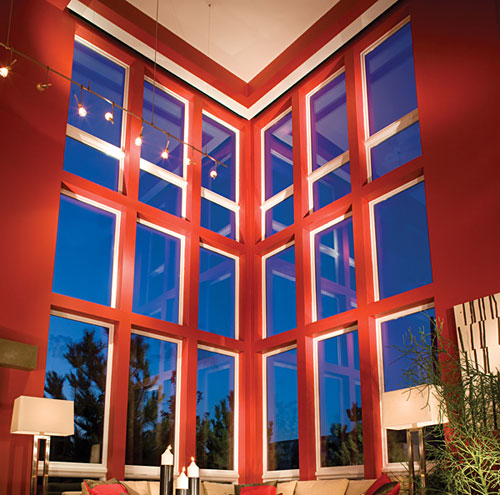Fiberglass Fenestration Comes into its Own
Fiberglass: What is it and How is it Made?
Fiberglass is a composite structural material that consists of fiber reinforcements, typically glass, that are bound together in a resin matrix. Unlike common fiberglass used in pools, boats, and storage tanks, fiberglass frames are produced via pultrusion, a process in which glass rovings and mats are pulled at tremendous force through a resin bath and a series of dies where the resin sets to the desired shape and the materials combine and catalyze to provide high tensile and torsional strength. These dimensionally stable fiberglass lineals are then assembled into window frames, which can be filled with foam insulation and glazed with high-performance low-E insulating glass for higher performance. Fiberglass window frames are produced similarly to vinyl, however where fiberglass is pultruded, or pulled, vinyl is extruded, or pushed, through a form to create a similar shape.
 |
Fiberglass windows add sustainability and beauty to a home. Photo: Levi Ellyson |
Â
Attributes of Framing Materials
The window frame, which makes up some 20 percent of the total window area, is an important factor in a window's total performance.
Wood
Wood is a readily available frame material, and the most common choice for homes. Strong and easy to work with, wood is a natural insulator and complements many forms of traditional home architecture. It can either be painted a solid color or stained and sealed to show off the wood grain.
Some significant downsides to wood windows have driven a switch to other frame materials. Wood frames require considerable maintenance to the exterior, with frequent touchups and occasional refurbishing, sanding and applying new coats of paint on a regular basis. Wood windows are also prone to rot, which can damage their integrity and make it difficult for the frames to hold paint. Some manufacturers of wood windows will offer cladding. However, some cladding materials can conduct heat and cold while others offer limited color options and cannot be painted. In addition to the inherent problems caused by varying expansion rates of two dissimilar materials, the wood beneath all cladding is susceptible to water damage that seeps behind the cladding material and rots the wood.
Wood's characteristics include:
- Available in custom colors and designs
- Provides excellent insulation
- Traditional look fits many home styles
- Susceptible to rot and water damage
- Requires maintenance
Table 1 - Comparison of Frame Material Physical Properties |
|||||
Property |
Units |
Vinyl2 |
Aluminum3 |
Aluminum3 |
Fiberglass2 |
Modulus |
PSI |
4.1 x 105 |
1.1 x 107 |
1.1 x 107 |
6.5 x 106** |
Yield Stress |
PSI |
8,000 |
35,000 |
35,000 |
60,000 |
Thermal |
BTu/hr-ft-ËšF |
0.110 |
140 |
140 |
0.11 |
Coefficient of Expansion |
in./in. ËšF |
29 x 10-6 |
12.3 x 10-6 |
12.3 x 10-6 |
4.4 x 10-6 |
Heat Deflection Temperature |
ËšF |
135 |
N/A |
N/A |
280 |
U Value1* |
None |
0.30 |
0.55 |
0.45 |
0.30 |
*Based on comparison of like-sized casement windows with double low-E (low solar gain) glazing |
|||||









